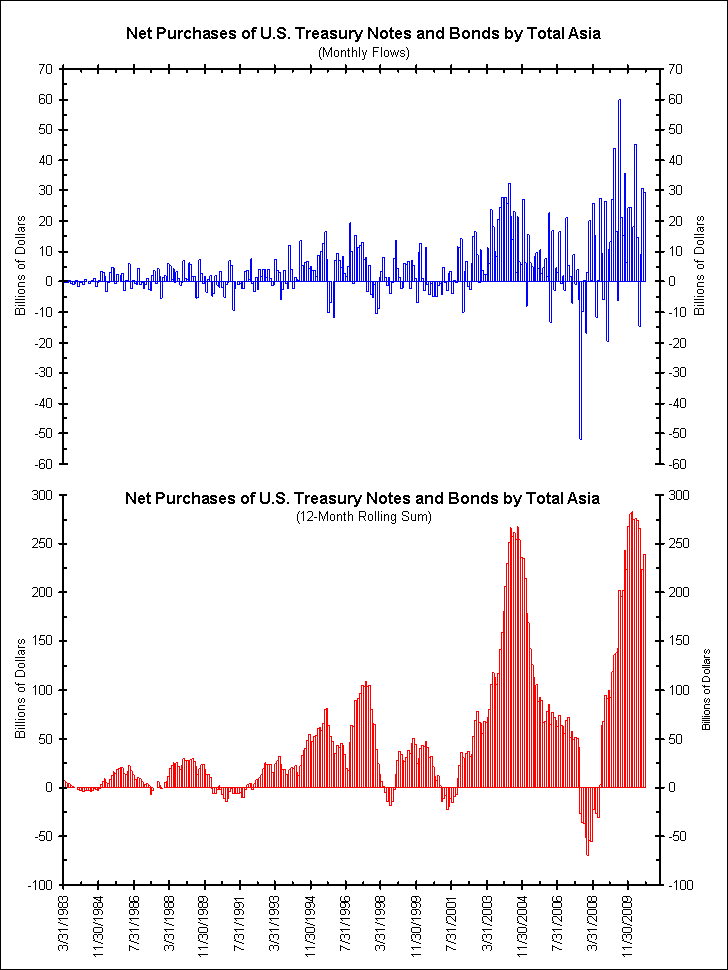James Bianco:
- The Wall Street Journal – Bond Market Defies Fed
Bucking the Federal Reserve’s efforts to push interest rates lower, investors are selling off U.S. government debt, driving rates in many cases to their highest levels in more than three months. The Fed’s $600 billion program to buy Treasury bonds began late last week and is kicking into high gear this week, with the central bank buying up tens of billions of dollars of debt. That should have driven prices up on those bonds and lowered their interest rates, or yields, which move opposite to the price. Instead, yields on almost every Treasury have been rising. The trend is a potential problem for the economy and the Fed. Rates had fallen sharply for months in anticipation of a Fed buying program, and in a short time much of that effect has been lost, spelling an unwelcome rise in borrowing costs throughout the economy. That could throw a wrench in what the Fed is trying to accomplish: to use low rates to encourage more borrowing and risk-taking by consumers, businesses and investors, thereby reviving growth. Still, it is far too early to declare that the Fed’s plan is failing, and many rates remain near historic lows.
Comment
Over the last several weeks we have repeatedly mentioned the Federal Reserve’s portfolio balance theory. In a nutshell, this theory states it does not matter what securities the Federal Reserve buys with newly printed money (QE2). The market will arbitrage this new money into the market that it thinks will have the most impact.
Right now the markets think that newly printed dollars will benefit “risk on” markets like stocks and emerging markets. So, Treasury purchases are a conduit to the “risk on” markets. However, Treasuries will still respond to the ups and downs of the economy, inflation expectations and international capital flows like they always do.
Given this, what is bothering the Treasury market so much since the inception of QE2? While the arguments laid out in this story are indeed valid, we would like to suggest a more traditional reason for the recent spike in yields. The market is worried that capital flows from China and Japan are about to slow.
In a Market Fact yesterday (audio) we said:
The volatility of zero-coupon ten-year Treasury notes (thick blue line, right-hand chart) declined between June and the same August 11, 2010 date Yuan volatility began to increase and has been on the rise since then. The normalized range of CNY volatility, its daily high-low range divided by the previous day’s close, has declined as both volatility measures have increased. We can interpret these dual moves as the currency market being more certain about the CNY’s direction and the Treasury market starting to price in higher hedging costs.
QE2 money merely passes through Treasuries on its way to other places. Additionally, if the Chinese are intent on slowing their economy to hold down inflation, capital flows from both China and Japan will slow in order to maintain their respective currencies against the U.S. dollar. Certainly QE2 is heightening inflation concerns in China; see the multiple reserves requirement hikes in recent days.
Later today the Treasury department releases the September Treasury International Capital (TIC) flows. The chart below shows purchases of Treasury securities from Asia (which is essentially China and Japan) on a monthly basis (top panel in blue) and a rolling 12-month basis (bottom panel in red) through August. As the bottom panel better shows, Treasury purchases from Asia have been slowing in recent months.
If QE2 is raising inflation expectations, thus accelerating China’s desire to slow their economy, the Treasury bond market is losing a major buyer. Not surprisingly, yields are going higher.
Is this what the Federal Reserve had in mind?
<Click on chart for larger image>



What's been said:
Discussions found on the web: